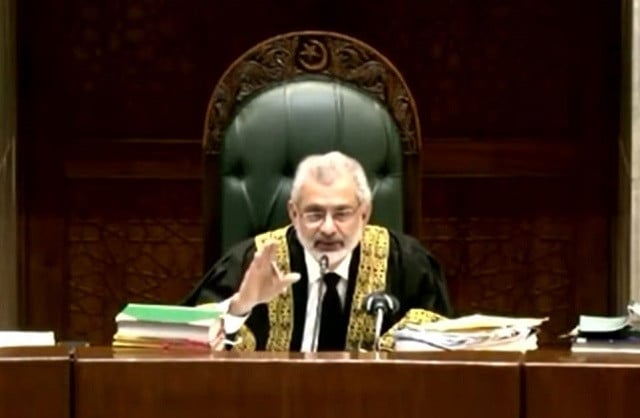
Chief Justice of Pakistan Qazi Faez Isa has undertaken the formidable task of ensuring the implementation of his 2019 judgment in the Faizabad Dharna case, firmly asserting that "there will be no future of Pakistan without accountability."
His statements during the case proceedings underscore his unwavering commitment to see action taken in accordance with the sit-in judgment, which raises questions about the role of the security establishment in shaping national politics.
The chief justice's remarks have ignited a debate regarding whether the Supreme Court, led by Justice Isa, will succeed in holding accountable individuals from the security establishment who are alleged to have violated their oath by exceeding their constitutional mandate.
In contrast to his predecessors, CJ Isa has consistently exhibited courage and a willingness to question powerful circles, despite facing significant repercussions for doing so.
Lately, Attorney General for Pakistan Mansoor Awan provided a strong assurance on behalf of state institutions regarding the implementation of the Faizabad sit-in ruling, requesting one month's time to comply with the orders.
So far, no responsibility has been fixed in the judgment. Now the ball is in the government's court to conduct an inquiry.
Since March 2009, the superior judiciary has mostly held politicians accountable. Several lawmakers, including three prime ministers were disqualified.
However, the superior judiciary has failed to implement its judgments on powerful circles. The same was witnessed in the Asghar Khan case judgement which was announced in October 2012.
Despite the passage of 11 years, the apex court could not implement its directions for taking action against former army chief Gen (retd) Aslam Beg and the then DG ISI Asad Durani. Since April 2019, no hearing is conducted in the SC regarding the implementation of the Asghar Khan case judgement.
Although the Supreme Court was successful in completing the trial of former army chief Gen (retd) Pervez Musharraf in the treason case, appeal in this matter is still pending for the last four years. It is an open secret that the superior judiciary faces strong resistance in the implementation of its verdicts related to the security establishment.
Justice Isa has one year to implement his ruling in the Faizabad Dharna case.
It is also to be seen whether the chief justice, while conducting the proceeding regarding non-implementation of the Faizabad judgement, will focus on some individuals or on institutional reforms.
The chief justice had to face a presidential reference for pronouncing the judgement. It is challenging for him how he will maintain a balance in the execution of the judgment.
He also asked as to why the review petitions were not fixed for the last four years. He wondered whether powerful circles were controlling the fixation of cases during the last four years.
He referred one para of the judgment wherein it was mentioned that the case was not fixed for five months. Interestingly, former chief justice Mian Saqib Nisar was the chief justice at that time.
“We are also accountable to the people,” remarked the chief justice over non fixation of review petitions for last four years.
A lawyer says that it was a historical moment when all institutions, which were against CJ Isa on account of this judgment, are now requesting for the withdrawal of the review petitions. This implies that the institutions are implicitly accepting his judgment.
Other important thing is that all stakeholders, including the government institutions, the PTI, etc., are satisfied with the Faizabad Dharna case judgement. Currently, the Supreme Court is not facing resistance in the implementation of judgement.
However, it is unclear whether the chief justice will implement the judgment for the institutional reforms by curtailing the institutions to work within their constitutional domain or will he compel authorities to take action against a few individuals.

1719660634-1/BeFunky-collage-nicole-(1)1719660634-1-405x300.webp)

1732276540-0/kim-(10)1732276540-0-165x106.webp)

1732274008-0/Ariana-Grande-and-Kristin-Chenoweth-(1)1732274008-0-165x106.webp)
1724249382-0/Untitled-(640-x-480-px)1724249382-0-270x192.webp)


1732270499-0/Express-Tribune-(7)1732270499-0-270x192.webp)
1732267715-0/BeFunk_§_]__-(32)1732267715-0.jpg)







COMMENTS
Comments are moderated and generally will be posted if they are on-topic and not abusive.
For more information, please see our Comments FAQ